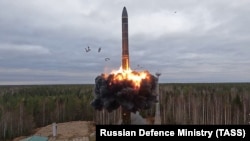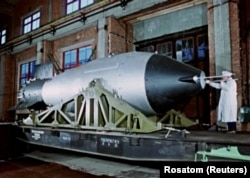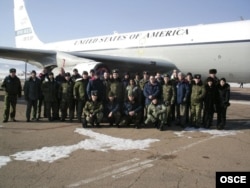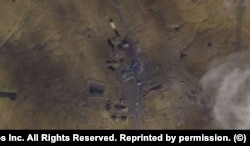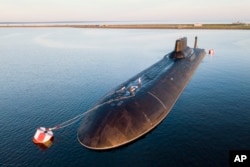The Anti-Ballistic Missile Treaty. The Intermediate-Range Nuclear Forces Treaty. The Treaty on Open Skies. New START.
For years, the pillars of international arms control have been crumbling: agreements signed by Washington, Moscow, and others during and after the Cold War aimed at reducing the threat of nuclear war, costly arms races, or overall military tensions.
The Comprehensive Nuclear-Test-Ban Treaty may be the next to go.
Signed in 1996, the treaty was a major step to preventing the spread of nuclear weapons technology and keeping a lid on the arsenals of the world's biggest nuclear powers. Along with earlier treaties, the agreement, known as the CTBT, also aimed to reduce the spread of radioactive material that was blasted into the atmosphere and the oceans during the frenzied days of the Cold War.
Here's the problem: The treaty never went into effect because a number of countries, including the United States, never ratified it. Still, most signatories -- including Russia and the United States, whose arsenals are by far the biggest in the world -- have abided by the ban.
Now, however, Russia is making noises about backing out and "de-ratifying" the treaty.
Here's what you need to know about the CTBT and its potential unraveling:
How'd It Come About?
The United States and the Soviet Union, as well as Britain, conducted hundreds of nuclear tests between 1945, when the world's first atomic bomb was detonated in the U.S. state of New Mexico and 1961, when Soviet officials detonated the world's most powerful weapon, the Tsar Bomba. France joined the nuclear testing club in 1960; China, in 1964.
The fallout, literal and figurative, from the testing led to a partial ban on atmospheric, oceanic, and space tests in 1963; underground tests continued to be allowed.
In 1974, India tested its first nuclear device, further expanding the nuclear club. A 1980 test by China became the last atmospheric test by any country anywhere.
Moscow's final test -- underground -- occurred in October 1990 on the remote Arctic archipelago called Novaya Zemlya. Britain, the United States, France, and China all conducted their final tests in the years that followed, prior to 1996, mainly underground.
What's It Do?
The CTBT basically bans all tests that result in a fission chain reaction, essentially a nuclear explosion.
Signed in 1996, the treaty was sent out to 187 signatory countries for ratification, but it has never come into effect because of a group of holdout countries.
Russia signed and ratified the treaty in 2000. The United States signed, but the U.S. Senate refused to ratify, citing concerns about verifying other countries' compliance with the ban. Despite nonratification, the United States has complied with the moratorium. China signed but didn't ratify.
Neither India, nor Pakistan, nor North Korea -- all of which have conducted open nuclear tests since 1996 -- is a member.
The treaty does allow for states to conduct subcritical, or zero-yield tests. Those involve explosives and nuclear materials but do not result in a fission reaction, the reaction that gives atomic weapons their terrible power. Both the United States and Russia are known to have conducted such tests.
Despite not ratifying the treaty, the United States does provide $33 million annually in funding for a system set up to monitor possible nuclear tests, as well as the Vienna-based organization charged with overseeing it.
What's The Problem Now?
As relations between Washington and Moscow have worsened, major treaties between them have also frayed or collapsed entirely.
Washington unilaterally pulled out of the Anti-Ballistic Missile (ABM) treaty in 2002, angering Moscow. Washington for years accused Moscow of trying to cheat on the Intermediate-Range Nuclear Forces (INF) treaty until it effectively collapsed in 2019. In 2021, Russia withdrew from the Treaty on Open Skies, which allows countries to conduct surveillance flights over one another's territories in order to observe weapons and military sites.
Both countries have adhered to New START, which capped the number of warheads and "delivery vehicles" each could possess.
New START's extension, by both Russia and the United States in early 2021, was a lone bright spot in the continuing erosion of arms control.
But the agreement expires in 2026 and cannot be extended. Unless a successor treaty can be agreed upon and ratified, there will be no limits on the countries' arsenals after that year. Tensions over Ukraine have kept the two sides from even sending inspectors to one another's countries, as stipulated for in New START.
Both countries have also moved to modernize and upgrade their arsenals. But in a sign of deepening distrust, the U.S. State Department suggested in a 2022 report that Russia had not adhered to the standard of "zero-yield" testing.
So Russia Wants To Pull Out Then?
For more than a decade, the Kremlin has increased spending not only on conventional weapons and force strength but also on modernizing and expanding its strategic arsenal.
In 2018, Putin boasted that Russia was developing new weapons like an unmanned, nuclear-capable, underwater torpedo, and a hypersonic "glide" missile. He also bragged of the development of a nuclear-powered cruise missile -- the Burevestnik, which has had major problems.
In recent years, researchers have been monitoring a surge of activity on the Novaya Zemlya archipelago: satellite imagery showing an uptick of construction at one or possibly two settlements that researchers had identified as sites for a possible test of a nuclear device or the trouble-plagued Burevestnik.
A top Russian nuclear researcher called for Russia to resume testing, and on October 5 Putin announced a successful test of the Burevestnik, though he provided no details.
Putin also opened to the door to Russia resuming nuclear testing, saying it could "de-ratify" the CTBT. A week later, on October 12, the speaker of the State Duma, the lower house of parliament, introduced legislation to withdraw ratification.
The prospect of Russia withdrawing prompted alarm bells, including from the CTBTO, the Vienna-based organization charged with monitoring compliance.
What Happens Next?
Even if "de-ratification" ends up happening, as is likely in the Kremlin-controlled parliament, that does not necessarily mean Russia will start blowing up uranium or plutonium again, on Novaya Zemlya or otherwise.
"I think that withdrawal of ratification is a strictly political step -- leveling status with the U.S.," said Nikolai Sokov, a former Russian Foreign Ministry official and arms control expert. "I think the main motive is the perception that 'Russia tried too hard in the past and made too many concessions' and now 'We're not interested in arms control more than other countries.'"
Leonid Slutsky, head of the Duma's foreign affairs committee, emphasized that Russia would not be withdrawing its signature under the treaty or "withdrawing from the voluntary moratorium on nuclear testing."
"We are withdrawing the ratification, thus restoring legislative parity with the U.S. Congress," he told the newspaper Kommersant.
"It was especially important for [the CTBTO] to hear that revoking ratification does not mean that Russia intends to resume nuclear tests and implies that Russia will continue to fully participate in the work being done for the Treaty's entry into force," Mikhail Ulyanov, Russia's ambassador in Vienna, told the state news agency RIA Novosti.
Still, it's not a good sign, experts say -- all the more so, given the demise of other treaties.
Russia or any major nuclear power backing out of the CTBT "would be a huge blow to the [global nonproliferation] regime and would undoubtedly lead to a cascade of nuke testing by other states," Lynn Rusten, a former U.S. arms control negotiator, told RFE/RL.
There could also be other nonproliferation or arms control treaties that are at risk, since, according to Sokov, the Kremlin has initiated a review of all similar agreements.
One strong candidate for "de-ratification" or a downgrading of Russia's involvement, he said, is the 1992 Chemical Weapons Convention, which obligates members to destroy their stocks of chemical weapons.
Russia's compliance with that treaty has been in question since the near-fatal poisonings of former Russian intelligence agent Sergei Skripal in England in 2018 and opposition activist Aleksei Navalny in Siberia in 2020.
In both cases, Western scientists identified a powerful Soviet-era nerve agent and suggested that Russia had maintained a secret, undeclared chemical weapons program.




